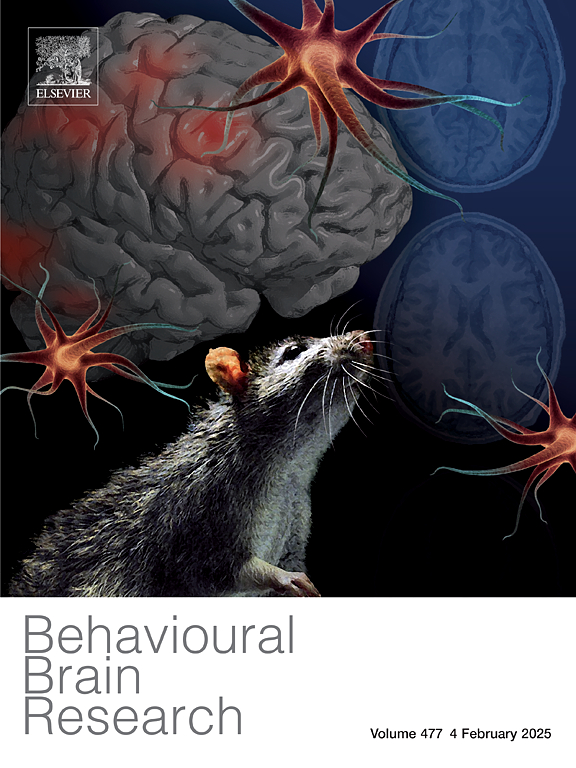在手术绝经大鼠模型中,菊花素可预防急性应激诱导的焦虑样行为,但不能预防绝望样行为:与外侧隔膜fos免疫反应性相关
IF 2.6
3区 心理学
Q2 BEHAVIORAL SCIENCES
引用次数: 0
摘要
卵巢切除术导致的卵巢激素浓度低增加了对压力不利影响的易感性。在大鼠中,长期卵巢切除术增强了焦虑和绝望样行为,并降低了外侧隔膜(LS)的Fos免疫反应性——外侧隔膜是与焦虑和抑郁的病理生理以及抗焦虑和抗抑郁药物的药理作用有关的大脑区域。黄酮类菊花素在临床前研究中表现出抗焦虑和抗抑郁的作用;然而,它在去卵巢大鼠中预防应激引起的行为和神经生物学变化的能力尚不清楚。雌性Wistar大鼠,卵巢切除术后11周,分为6组:对照组(无操作);车辆;菊花素(0.5、1或2 mg/kg,腹腔注射)或地西泮(2 mg/kg,腹腔注射)。治疗连续7天,在最后一次注射后1 h,大鼠暴露于15分钟的游泳诱导应激期。24 h后通过高架+迷宫、运动活动测试和强迫游泳测试评估行为结果。测定了Fos在LS中的免疫反应性。急性应激增加了LS患者的焦虑和绝望样行为,显著降低了Fos的免疫反应性。1和2 mg/kg的Chrysin可阻止焦虑样行为,但不能阻止绝望样行为,并恢复腹侧LS的Fos免疫反应性。所有组的运动活动均未受影响。这些发现表明,长期卵巢切除术增加了压力引起的焦虑和绝望行为的脆弱性,这可能部分由菊花素缓解。尽管菊花素显示出作为一种非激素治疗手术绝经后焦虑的潜力,但由于其溶解度低、生物利用度差以及毒理学数据有限,值得进一步研究。本文章由计算机程序翻译,如有差异,请以英文原文为准。
Chrysin prevents acute stress-induced anxiety-like, but not despair-like, behavior in a rat model of surgical menopause: Association with Fos-immunoreactivity in the lateral septum
Low concentrations of ovarian hormones resulting from ovariectomy increase susceptibility to the adverse effects of stress. In rats, long-term ovariectomy enhances anxiety- and despair-like behaviors and reduces Fos immunoreactivity in the lateral septum (LS)—a brain region implicated in the pathophysiology of anxiety and depression, as well as the pharmacologic effects of anxiolytic and antidepressant agents. The flavonoid chrysin has demonstrated anxiolytic- and antidepressant-like effects in preclinical studies; however, its ability to prevent stress-induced behavioral and neurobiological changes in ovariectomized rats remain unknown. Female Wistar rats, 11 weeks post-ovariectomy, were assigned to six groups: control (no manipulation); vehicle; chrysin (0.5, 1, or 2 mg/kg, intraperitoneally), or diazepam (2 mg/kg, intraperitoneally). Treatments were administered for seven consecutive days, and 1 h after the final injection, rats were exposed to a 15-minutes swim-induced stress session. Behavioral outcomes were assessed 24 h later using the elevated plus maze, locomotor activity test, and forced swim test. Fos immunoreactivity in the LS was also quantified. Acute stress increased anxiety- and despair-like behaviors and significantly reduced Fos immunoreactivity in the LS. Chrysin at 1 and 2 mg/kg prevented anxiety-like, but not despair-like behavior, and restored Fos immunoreactivity in the ventral LS. Locomotor activity was unaffected across all groups. These findings suggest that long-term ovariectomy heightens vulnerability to stress-induced anxiety- and despair-like behavior, which may be partially mitigated by chrysin. Although chrysin showed potential as a nonhormonal strategy for managing anxiety associated with surgical menopause, challenges related to its low solubility, poor bioavailability, and limited toxicological data warrant future investigation.
求助全文
通过发布文献求助,成功后即可免费获取论文全文。
去求助
来源期刊

Behavioural Brain Research
医学-行为科学
CiteScore
5.60
自引率
0.00%
发文量
383
审稿时长
61 days
期刊介绍:
Behavioural Brain Research is an international, interdisciplinary journal dedicated to the publication of articles in the field of behavioural neuroscience, broadly defined. Contributions from the entire range of disciplines that comprise the neurosciences, behavioural sciences or cognitive sciences are appropriate, as long as the goal is to delineate the neural mechanisms underlying behaviour. Thus, studies may range from neurophysiological, neuroanatomical, neurochemical or neuropharmacological analysis of brain-behaviour relations, including the use of molecular genetic or behavioural genetic approaches, to studies that involve the use of brain imaging techniques, to neuroethological studies. Reports of original research, of major methodological advances, or of novel conceptual approaches are all encouraged. The journal will also consider critical reviews on selected topics.
 求助内容:
求助内容: 应助结果提醒方式:
应助结果提醒方式:


